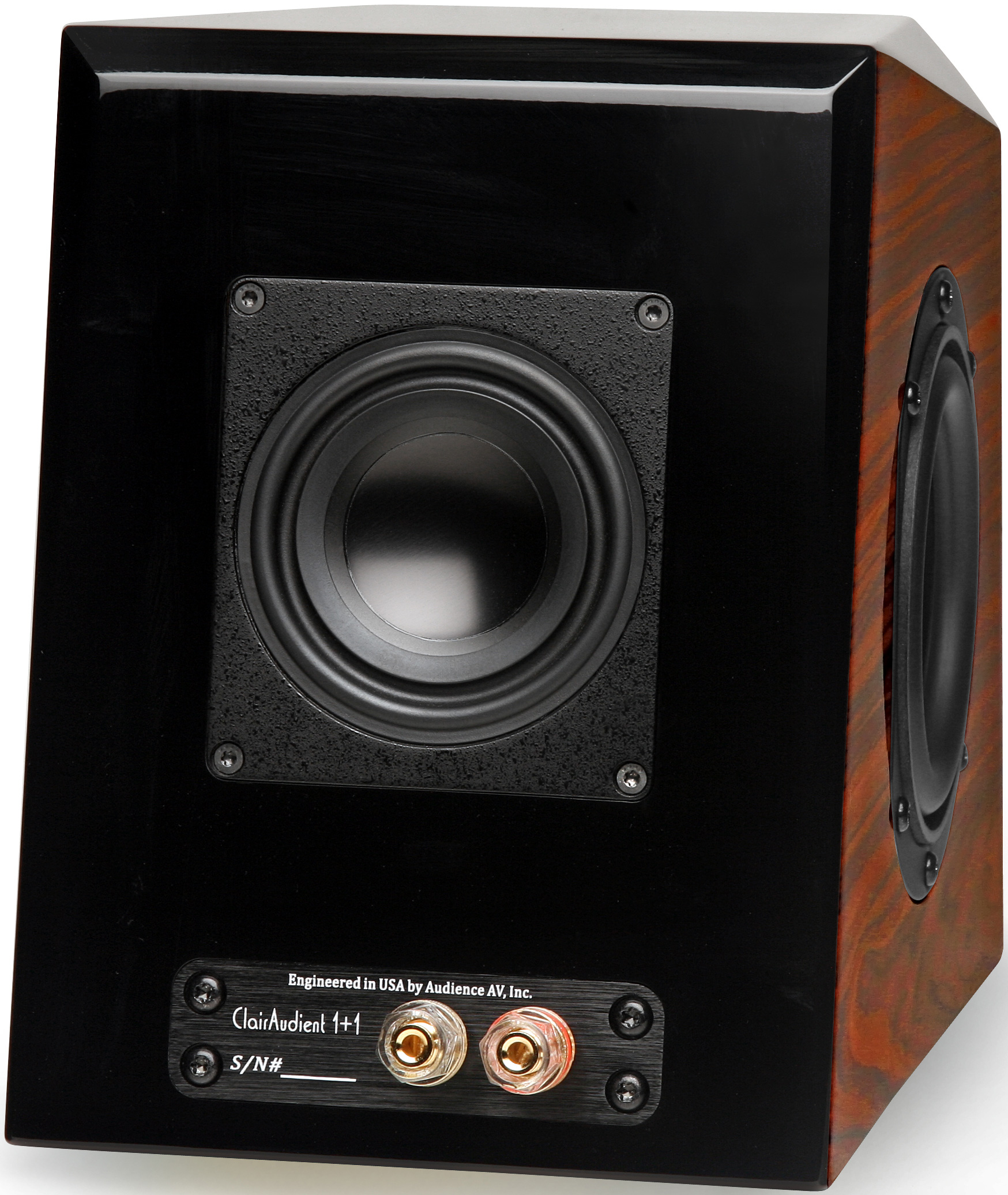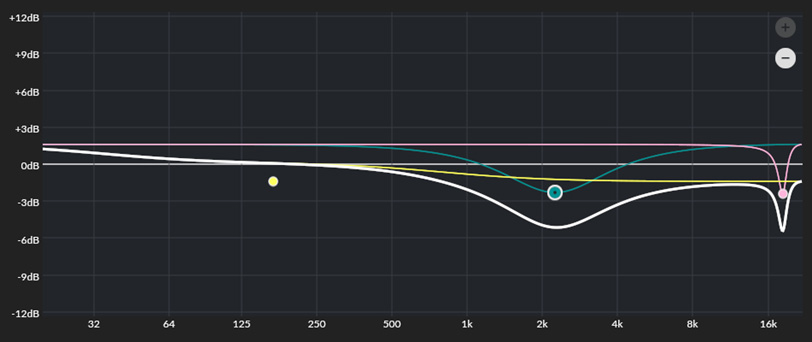My Next Step
When I discussed my interest in exploring single-driver loudspeakers with my editor at Dagogo, he offered to have the Audience ClairAudient 1+1 monitors sent to me for review. In photos, they looked more like chunky desktop computer speakers than serious stand-mounted contenders, but curiosity got the best of me, so I accepted the assignment.
The ClairAudient 1+1 is a small monitor-style loudspeaker. Its cabinet is finished in high gloss on all sides and is simply gorgeous in person. Tremendous attention to detail went into its construction. The top, bottom, front and rear baffles are deep black, while the sides are rosewood, one of my favorite speaker finishes. In the center of the non-parallel front and rear baffles, both canted back a few degrees, there is the three-inch A3S2-16 driver. It operates in-phase, making the 1+1 a bipolar design. The sides each sport a four-inch passive radiator to fill out the bass.
The 1+1 gets its name from an older but smaller sibling, called “the ONE.” This palm-sized loudspeaker has half the driver complement: a single A3S2-16 driver on the front and one passive radiator on the back. The 1+1 has undergone several revisions since its introduction at CES in 2016. I received Version 4, which includes improved passive radiators and top-of-the-line Eichmann ultra-low mass pure copper binding posts.
They arrived with a pair of Audience studioONE speaker cables, which I appreciated. John McDonald explained that the speakers would sound their best with these cables. He even included samples of Deoxit to ensure the best connection.
Initially, I placed the 1+1’s on the same 30-inch sand-filled stands I’ve used with the Fritz monitors. These were a little over six feet apart and seven and a half feet from ear to speaker. Not surprisingly, the 1+1 monitors sounded small. However, I could easily hear their potential. I just needed to put a little more effort into optimizing placement, something that’s true for any significant speaker change.
Because the front baffle on the 1+1 is raked back a few degrees, John suggested that I place them on shorter stands, which resulted in more extended highs reaching the listening position. Going through my usual setup tracks, I discovered that the 1+1s need to be closer together to achieve good bass coupling. Placing them four feet apart helped significantly to achieve natural-sounding vocals, and moving them forward so that they were five feet from my ears made them sound much larger than they look.
In this nearfield setup is when it happened. I encountered the next level in coherency. With the 1+1 positioned optimally, the first words out of my mouth were, “man, these things are trippy!” Even though they were near the listening position, the soundstage was way behind the speakers. Depending on the recording, I could sometimes localize hard-panned sounds to a speaker; otherwise, the stage was completely detached, which is what I’m going for. I could not believe what I was hearing. The problem with coherency is that once you hear it, you can never “unhear” it.
My wife prepared herself to be disappointed when I sat her in front of what looked to her like a pair of computer speakers. Even though she was in no mood for my audio tweaking shenanigans that particular evening (being an audiophile’s spouse is not always easy), she was blown away by what she heard: complete detachment of sound in the room from the diminutive speakers just a few feet in front of her. What started as me demoing the new setup with a track or two turned into a two-hour listening session, culminating with Ashkenazy playing Rachmaninov’s 2nd piano concerto.
I stayed up late for several nights listening to track after track, marveling at spatial information that was present in many of my favorite recordings but largely unheard up to that point. I never got the sense that the 1+1s were artificially embellishing these recordings. In fine sound reproduction, products cannot add fidelity; the best they can do is minimize the degree to which they get in the way. I’m convinced that this is what the 1+1 was doing in my room.
The ClairAudient 1+1’s Next Step
While soundstage and imaging were a revelation, after spending more time with the ClairAudient 1+1, it became apparent that the tonality was a little off of neutral. Most recordings sounded delightful, but some were excessively forward in ways I had not noticed with other loudspeakers. I pulled out my miniDSP UMIK-2, calibrated by Cross-Spectrum Labs, and recorded a few sweeps from my listening position to better understand what I was hearing.
I found a roughly four to six dB hump in response, centered around 2.2 kHz, and another narrow-band spike at approximately 18 kHz. After a few minutes of adjusting parametric equalizer settings in Roon, I arrived at a correction curve that gave the 1+1s a neutral tonality:
I was so pleased with the results that I shared them with John McDonald. He introduced me to Audience designer Phil Ducote, who has been working on improvements to the 1+1s over the last few years, including re-tuning the passive radiators for a smoother and more extended response in the mid-bass region. The next improvement he had planned was a “voicing circuit” to address the rise in midrange response that I was hearing. Phil said he might combine this with a baffle step correction circuit (something I had asked about in our email exchange), but smoothing out the midrange would have a similar effect. For the circuit implementation, naturally, Phil used Audience Auricap XO+M high-resolution capacitors.
A few weeks later, I received the very first “Version 5” ClairAudient 1+1 loudspeakers. They were so new that they still had “V4” stamped on the serial number plates. I set the original V4s aside, disabled my PEQ settings in Roon, and queued up familiar tracks. I was surprised by how much fuller the V5 sounded. In my room, the V4 had to be paired with a subwoofer to deliver anything resembling full-range sound. To my astonishment, the new V5 rendered satisfying bass and top-to-bottom neutrality for a wide swath of my music without augmentation. Not only that, but the bass had excellent tone, texture, and pitch definition. The V5 delivered that warbling interplay among the strings on Paul Chambers’ bass during the first thirty seconds of “So What” on Kind of Blue with uncanny clarity.
- ← Previous page
- (Page 2 of 4)
- Next page →
- ← Previous page
- (Page 2 of 4)
- Next page →



Hello,
As an enthusiastic AUDIENCE dealer, I found your review of the ClairAudient 1+1 V5 and interview with John MacDonald to be informative and inciteful.
Thank You,
Isadore Nudell/ Codell Audio
Great review. I’d like to hear your thoughts on best amplification for the 1+1 V5s. How much, what kind? I’ve long had The Ones in a desktop setup; with condo downsizing am considering V5s as main speakers.
I would also like to hear some user experience in amplification for the 1+1s. McIntosh has a new series of hybrid amps and integrated amps. Atmosphere, know for OTL amps now makes class D amps which are receiving high praise. So many different amps out there now.
Hi Isadore,
Thanks for your kind words. I’m confident that your customers will love the new V5’s. I’d encourage you to reach out to your existing customers to let them know about the upgrade opportunity. The previous versions were already great, but at the cost of a little efficiency, the V5 offers a completely different level of performance.
— David
I’ve got a pair of 1+1 v3 for about 3 years. Very good sound for their size, which is their most impressive feature but didn’t think they were crazy amazing … so 3 years of “nice” listening. But it changed few months ago. I started fooling with their spacing from EACH other and from the BACK wall. Apparently these need to be several feet from the back wall and well separated. Once that happened, they transformed into “oh my god” speakers. Wow. Went from 5′ separation to about 7′ separation and 1.5′ to 2.5′ from back wall. Night and day difference. They’re about 8′ from the listening spot, and slightly canted inward to create a larger sweet spot. Yeah, the hype is really true but you need to get the spacing right, especially distance from the back wall. Also, they tended to open up sonically after several months. I’m planning on getting the v5 upgrade shortly.
Thanks David for an excellent review on the Audience 1+1. I am sold on coherence. The Audience 1+1 V4 are standing each 10in atop a SVS 3000 micro subamp. The speaker combo is 4ft from the back wall and 8ft apart. Listening area is at 20ft from speakers. I delt with the 2k emphasis with the insertion of a Schiit mini loko between my Shindo preamp and my Audio Mirror SET amp. This is audio heaven for me for all the reasons you mention in your review. I am totally confident that I hear what is there and I am sorry for those who spend big dollars for less. In the rare instances I need more than 84dB at my listening space I use my Klipschorns.